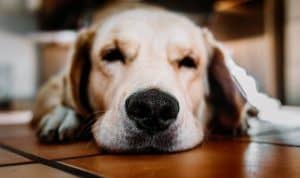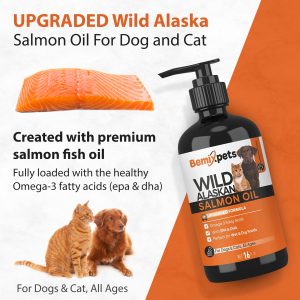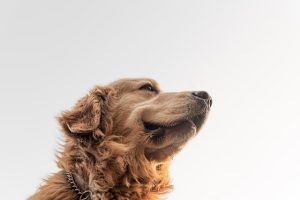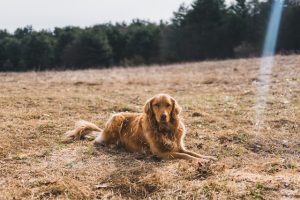You’re just sitting there watching TV when you suddenly hear your dog licking and licking a lot. You look over at him and notice that he has a big red sore that he is licking. What is that? It looks painful! Odds are good that your poor pup has a hot spot, and if it is a hot spot, it is painful. This is a very common condition. Let’s explore what hot spots are and some treatment options.
Contents
What Are Hot Spots?
Hot spots are caused by an immune response that could be caused by bug bites (including flea bites), a sore spot that the dog keeps licking and chewing, environmental allergies, other allergies, underlying disease, and possibly a mat of fur over the skin that does not allow the skin to breathe properly. Another possibility is that your dog is bored or stressed. These are another two culprits that can cause hot spots, however, they are rarely addressed by traditional vets.
Hot spots appear as red, moist, irritated, and occasionally oozy spots on the skin. They will usually appear very quickly and can spread rapidly. This makes it important to act quickly if you see a hot spot on your dog.
While hot spots can manifest anywhere on your dog they are most commonly seen on the side of a dog’s face, on his chest, neck, hindquarters, legs, and tail. Dogs with thick or long coats are more susceptible to hot spots than breeds with short or thinner coats.
My Dog Gets Hot Spots All The Time
So, what if your dog is getting hot spots all the time? What does it mean? Well, it very well could be a sign of underlying disease. Chronic hot spots may be a sign of muscle tension or pain, liver disease, or an immune disease. Be sure to consult your holistic or homeopathic vet if your dog is constantly dealing with painful hot spots.
How Are Hot Spots Treated?
A conventional doctor will treat the hot spot with antibiotics. This is not ideal for your dog’s long-term health. Antibiotics may help to get rid of any bacteria in the hot spot but it will also damage your dog’s microbiome.
The microbiome helps support your dog’s immune system, creating enzymes, creating amino acids, and breaking down food. If the microbiome is comprised your dog’s immune system is compromised and that will leave your dog’s body open for invasion for other pathogens. You can read our article about Probiotics and your Golden Retriever to learn more about the microbiome and how to support it.
Is There A Natural Treatment For Hot Spots?
When treating hot spots it is helpful to trim the hair of the surrounding area. Then you will need to clean the wound. Be very gentle and use lots of treats because the hot spot is very painful. Clean away any pus or dead skin.
Calendula is an herb that can prove very helpful for reducing itching and irritation of the hot spot. It can also help the skin to heal faster. You can use calendula topically, directly on the wound in the form of an oil, tea, or tincture. If you choose to use a tincture be sure to choose one that is not alcohol-based. Alcohol will sting and irritate the wound further. Calendula can be applied as often as needed and is safe for your pet to lick.
Hypericum or St. John's Wort can be added to calendula for even greater itch and inflammation relief. Adding hypericum to calendula can also promote healing even more. You can get calendula and hypericum tinctures and mix 13 or so drops of each with a cup of warm water. Then wash the hot spot with the water as often as needed. This will relieve itching and promote healing. As a bonus hypericum has natural antibacterial properties that seek out pathogens while leaving good bacteria alone.
You can also use black tea to help dry up the hot spot. The tannins in the tea can help to stop the infection and help with healing. Steep a bag of black tea in 8oz of water and then let it cool. You can either use the tea bag or a cotton ball soaked in the tea and hold it on your dog’s hot spot. You can hold the tea on your dog as long as he will let you. Again a few treats might come in handy to keep your dog occupied while you hold the tea bag on the wound.
Colostrum can help boost the immune system and speed up the healing process. Colostrum also acts as a natural antibiotic. You can use powdered colostrum and mix it with distilled water to make a paste to apply to the wound.
How To Prevent Hot Spots
Prevention is always best! So, here are a few ways to help prevent your dog from ever having to deal with painful and itchy hot spots. First of all, it is important to make sure that your dog is getting plenty of mental and physical exercise every day. Take a training class, go for a hike, join a dog sport club and go to events, put all your dog’s food in toys that are made to be stuffed with food, take daily walks. All this will help to prevent your dog from getting hot spots from boredom.
It is also a good idea to give your dog a good brushing to help prevent mats and get air to the skin. This is especially important with long-haired or thick-coated breeds. Brushing your dog daily is a great way to check on your dog’s health, prevent hot spots, and bond.
What you feed your dog can make a big difference as to how healthy he will be. Feeding a raw, species-appropriate diet is a great way to promote a healthy immune system. Your dog is what he eats so be sure to feed him a fresh, raw diet and not dead kibble.
Conclusion
Hot spots are uncomfortable, painful, and itchy for your dog. They are also irritating for us as owners because we hate to see our dogs in pain. You can use the conventional treatment of antibiotics for temporary success, however, the long-term effects of antibiotics are not worth it. It is far better to use natural treatments including things like calendula, hypericum, colostrum, and black tea. Prevention is even better! Help to prevent hot spots with a healthy lifestyle and exercise, a raw diet, and daily brushings.






Leave a Reply
You must be logged in to post a comment.